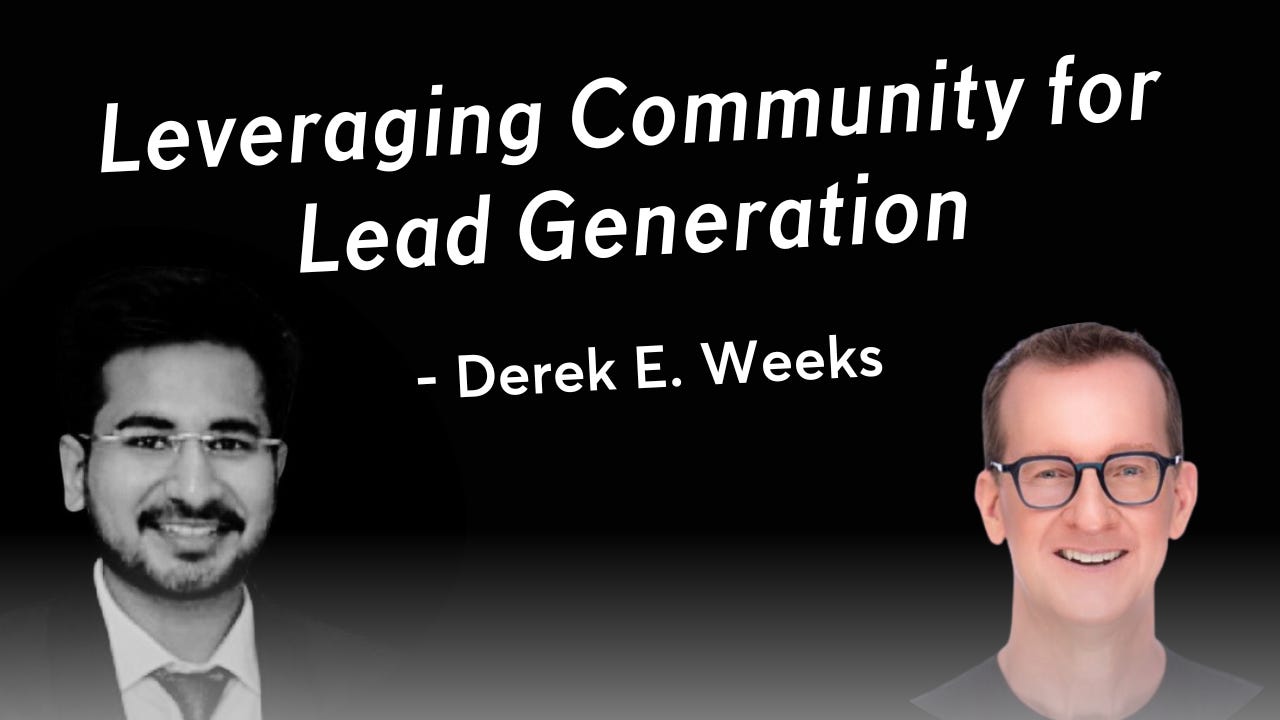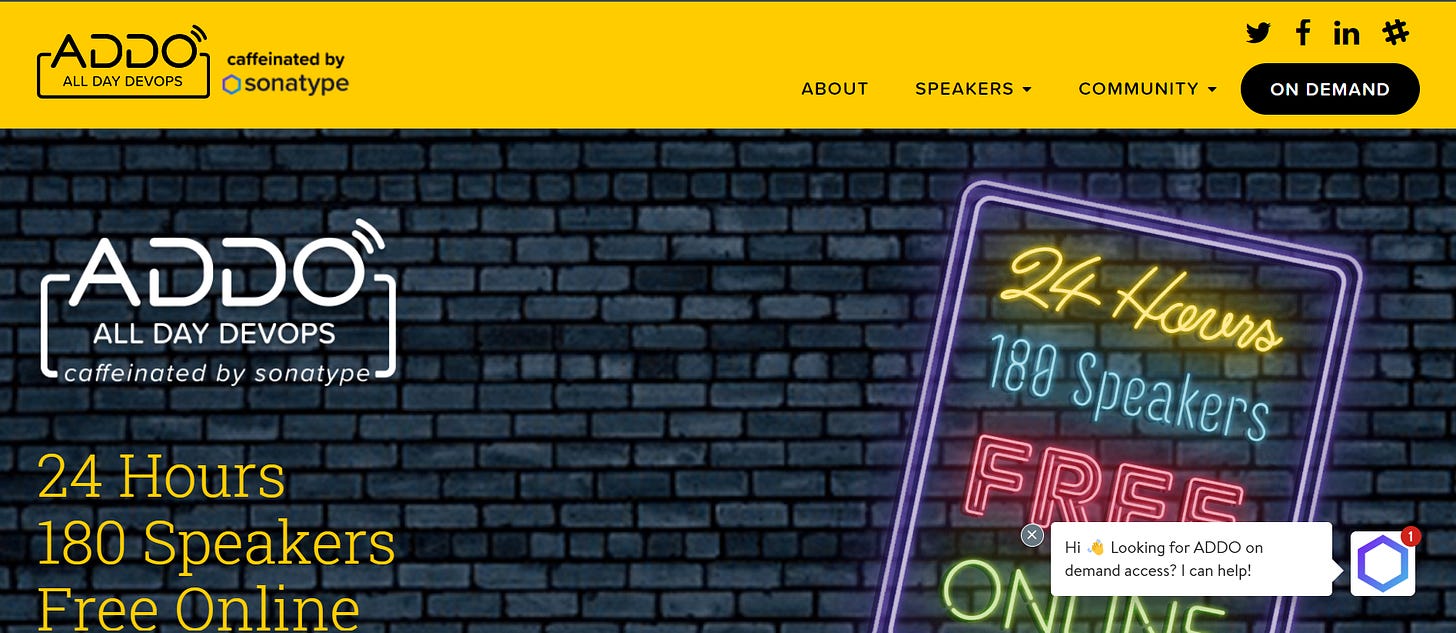Leveraging Communities for Lead Generation
Learn to build engaging, targeted communities that boost your marketing efforts, increase brand visibility, and drive sales. Explore techniques to transform community engagement into valuable leads.
👋 Hey, Ayush here! Welcome to this week’s ✨ free edition ✨ of Startup GTM Newsletter.
I have been building startups for the last 7 years and working with founders on GTM, growth, people-first strategies, communities and anything else about building a startup.
If you’re not a subscriber, here’s what you missed earlier:
Subscribe to get access to these posts, and every post. Follow me on Linkedin and Twitter. Want to discuss about collaboration or GTM? Setup a meeting on this link
“Harnessing community power can actually transform lead generation strategies” - Derek E. Weeks
In a market saturated with traditional advertising and continued increase in Noise to Signal ratio, turning to communities offers a fresh and authentic avenue for reaching potential customers.
74% of consumers rely on social networks to guide purchase decisions, underlining the influence of community opinions (Source).
Online communities report a 21% higher brand engagement, making community engagement a key asset in customer retention (Source).
49% of businesses with online communities report annual cost savings of 10% to 25% (Source)
Recently got a chance to interview Derek E. Weeks: CMO to Bestselling Author and DevOps Community Pioneer
Former Chief Marketing Officer for The Linux Foundation, VP Marketing for Sonatype, and Marketing Leader at Global 360 and Systar
Co-founder of All Day DevOps, a global community of over 100,000 DevOps
We discussed on various topics including
Sonatype Story - Success story of building community of 100K+ DevOps Professionals for lead generation
How community triggers can be linked to demand generation activities?
ROI of community initiatives for lead generation
How to attribute community activities?
Balancing automation and manual analysis for identifying triggers
Role of CMOs and CEOs
Building vs Leveraging existing communities
How to avoid failure while building a community for Lead Generation?
Pointer for CMOs - Evaluating communities for lead generation
Brief about “Unfair Mindshare - A handbook for CMOs” - a bestseller in Sales, Marketing and Community
Why did I invite Derek?
Derek's approach transcends traditional B2B marketing, focusing on understanding market needs and integrating products into the daily lives of users, rather than merely promoting products.
His success in expanding reach to 10 times larger markets, building strong brand reputations, and gathering valuable market data exemplifies the effectiveness of engaging communities and partnerships in demand generation.
He had built an expertise on planning and running a community that integrates and helps build demand.
Here is a Derek explaining about his relevant background
Sonatype Story
Success story of building community of 100K+ DevOps Professionals for lead generation
Discussion Takeaways -
Starting in 2016, Sonatype spearheaded the DevOps market's growth by launching a global-scale conference and community, initially attracting 13,000 participants.
Their approach focused on pure education without vendor pitches, expanding to a 24-hour format to cater to global audiences, resulting in a community surge to over 40,000 members
This strategic community building was intertwined with effective demand generation, driving millions in sales and establishing a profound market presence beyond their core product.
Video of Derek explaining the success of Sonatype
Community Triggers → Demand Generation
How community triggers can be linked to demand generation activities?
Discussion Takeaways -
Sonatype leveraged their global community conference to generate an abundance of SEO-rich content, created by the community itself, driving continuous engagement and visibility.
By transforming conference talks into blog posts and compiling them into published books, Sonatype created a cycle of content that kept the community engaged and attracted new members.
These books, used in industry events and book signings, not only boosted brand visibility but also seamlessly integrated community efforts into traditional demand generation cycles
The above strategic approach showcases how community-led initiatives can be effectively transformed into powerful demand generation tools, aligning community and company interests for mutual growth.
Video of Derek explaining how they used community triggers for demand generation
ROI
ROI of community initiatives for lead generation
Discussion Takeaways -
Tracking interactions and engagements within the community allows for precise qualification of potential leads, with a focus on nurturing them through community-driven content and activities.
Regular reporting on investment in community events, the generation of top-of-funnel leads, and conversion rates provides a clear picture of the community's impact on revenue generation.
By aligning community participation with account-based marketing strategies, companies can identify and target key accounts more effectively, enhancing their sales strategies.
This approach emphasizes the tangible benefits of community initiatives in lead generation, highlighting their role in generating significant revenue and strengthening account-based marketing efforts.
Video of Derek explaining ways to predict ROI in community initiatives
Attribution
How to attribute community activities?
Discussion Takeaways -
Community activities often serve as first touch points in top-of-funnel marketing, easily tracked through Salesforce campaigns and other CRM tools.
These activities are not just about engaging the community but also about leveraging it to create targeted marketing initiatives, like industry surveys, to gather insights.
The output of these community-driven activities, such as survey reports, becomes valuable content for lead generation, nurturing, and qualifying campaigns.
This approach underscores the importance of viewing community activities not just as engagement tools, but as integral parts of a strategic marketing and lead generation framework.
Video of Derek explaining about the attribution in community activities
Identifying Triggers
Balancing automation and manual analysis for identifying triggers
Discussion Takeaways -
Community content can evolve into campaigns, often fitting into a middle-funnel role, crucial for lead generation and potentially aligning with last-touch attribution models.
First touch attribution through community engagement may be challenging to track, but its influence is evident in the engagement of key tier one and tier two accounts.
Sales teams often provide anecdotal evidence of community efforts influencing deal closures, highlighting the indirect yet impactful role of community initiatives.
While not directly attributable in every case, the content and engagement generated by community activities play a significant role in shaping last-touch attribution and overall revenue generation.
Video of Derek explaining about identifying triggers through automation and manual analysis
Reporting
Role of CMOs and CEOs
Discussion Takeaways
CMOs should focus on cultivating communities as spaces for learning and connection, avoiding overt sales pitches that could alienate members.
Effective community management often resides within marketing, emphasizing the provision of value and knowledge rather than immediate sales.
Product-specific communities may align better with customer success teams, aiming to retain and engage existing customers through shared experiences and learning.
CEOs should recognize the broader potential of communities beyond immediate sales, understanding their role in nurturing long-term relationships and brand loyalty.
Video of Derek explaining where should the community reside in an org-chart
CMOs Dilemma
Building vs Leveraging existing communities
Discussion Takeaways -
Assess if building a community is feasible based on your business size and resources; smaller businesses (under $10 million in revenue) may find it challenging to maintain a thriving community.
For larger companies, dedicating a small portion of the marketing budget (5-12%) to community-led efforts can be beneficial, but it's vital to balance this with traditional marketing.
Commitment is key: Allocate approximately 1,000 hours yearly (half a full-time resource) to community engagement, whether building anew or participating in an existing community.
Leveraging existing communities can offer immediate influence and leadership opportunities, especially for businesses unable to dedicate substantial resources to building their own community from scratch.
Video of Derek answering whether to build or leverage community
Assuring Success
How to avoid failure while building a community for Lead Generation?
Discussion Takeaways -
Identify and deliver unique value beyond your product; focus on enhancing practice or knowledge in your field, not just product promotion.
Understand market saturation: in crowded markets like cybersecurity or marketing tech, creating a standout community is challenging due to the sheer number of existing communities.
Prioritize longevity and relevance: ask if your community would continue to exist and remain relevant if your company disappeared.
Start with a clear purpose: like product-market fit, ensure your community has a well-defined community-market fit, focusing on what members like Derek or Ayush would gain from joining.
Video of Derek explaining the ways to prevent failures in community initiatives
Evaluating Communities
Pointer for CMOs - Evaluating communities for lead generation
Discussion Takeaways -
Define the purpose of your community: Decide whether it's a product-focused community for customers or a practice-based community for broader engagement.
Assess community market fit: Identify what the community needs that existing groups don't provide, and how your community can fill that gap.
Maintain consistent brand promises: Like the All Day DevOps commitment to education and no vendor pitches, ensure your community's value proposition remains unchanged to foster trust and engagement.
Balance being helpful with business goals: Sixth Sense's CMO Coffee Talk exemplifies providing genuine value without direct product promotion, leading to increased brand trust and consideration.
About Unfair Mindshare (Bestseller by Derek)
A CMO's guide to community-led marketing in a product-led world
Unfair Mindshare isn't just another book on building communities; it's a CMO's guide to integrating community efforts with demand generation. Here's the gist:
Purpose Beyond Feel-Good: Building a community feels great, but how does it actually boost your company's revenue or customer retention? That's the real question.
Measuring Impact: As a CMO, it's crucial to demonstrate the community's tangible impact on the business's bottom line to justify continued investment.
Community and Revenue: Not every member of your community will directly contribute to revenue, but a significant portion should to validate the community's existence.
Strategic Investment: Understanding how to link community engagement with demand generation is key. It's about smart investment, not just feel-good actions.
This book is about making community efforts count where it matters most – in business growth.
Want to discuss collaboration or go-to-market strategy?
Subscribe to our newsletter for exclusive insights, tips, and expert advice.
Plus, schedule a 1:1 Brainstorming Meeting with Ayush through Calendly link!









